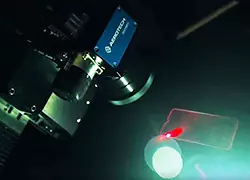1 min read
Comprehensive Guide to Motion Controller Programming
Motion Controller Programming Motion controller programming is the foundational activity that translates a machine's intended function—whether that...
Work with our team to determine which products or systems are the best fit for your application.
Some Aerotech products are available for immediate order in North America through our partner Motion Plus.

A case study examining display production that optimizes quality and throughput – and lower total cost.
In automated manufacturing, advanced research and industrial processes, absolute movement accuracy is a necessity. A motion control system serves as the primary mechanism for ensuring machines perform tasks with repeatable and deterministic positioning. Understanding the functional breakdown of this system is critical for optimizing machine performance and stability. These components are essential to achieving precision motion control, the engineering discipline that enables high-accuracy industrial and scientific applications by translating digital instructions into precise physical movement.
A motion control system typically comprises four functional component classes: actuators, feedback devices, drives and the central motion controller. Each plays an important role:
Actuators (commonly electric servo or stepper motors) generate the physical force or torque required to move a load.
The motion controller is the central processor, interpreting high-level user commands and translating them into time-based, low-level electronic signals.
Drives (or servo amplifiers) receive these control signals and convert them into the high-power electrical current necessary to energize the motor windings.
Feedback devices continuously measure the motor's actual position and velocity. These elements integrate to achieve predictable movement and positioning, enabling the system to compensate for external physical disturbances.
A motion control components diagram can help visualize these complex, interconnected relationships and the data flow within the control loop.

The three primary electromechanical devices central to motion control are the motors, drives and controllers. The controller is responsible for all motion planning. It calculates the motion trajectory—a mathematically optimized path that dictates position, velocity and acceleration over time—ensuring the motor follows a smooth, deterministic profile. The drive acts as the power stage: it takes the low-power command signal from the controller, modulates it (e.g., using PWM or linear amplification) and outputs the required high-power current to the motor. The motor converts this electrical energy into the mechanical force or torque used to accelerate and position the physical payload. Motion control automation companies use these three distinct, integrated devices to efficiently manage complex, multi-axis motion sequences. Synchronized operation is dependent on high-speed digital communication protocols linking these devices.
A precision stage is a mechanical platform designed to provide highly accurate, repeatable and fine positioning of a workpiece or tool. The construction of a precision stage typically incorporates the following components:
Base structure
Advanced linear or rotary bearings
Low-friction drive mechanism (such as a linear motor or preloaded ballscrew)
Integrated high-resolution feedback devices.
Its design objective is to minimize geometric errors – including straightness, flatness, pitch, yaw and roll – and maintain stability against environmental changes. Precision stages are used in critical applications such as semiconductor lithography, high-magnification microscopy and advanced laser processing. Precision motion systems use the capabilities of these precision stages, with the control electronics and software optimizing performance to the hardware’s mechanical limits.
Feedback devices function as metrology instruments within the motion control system, providing real-time data that is essential for closed-loop operation. These devices include:
High-resolution encoders (rotary and linear)
Capacitive sensors
Specialized metrology tools like laser interferometers
Position and velocity data is continuously transmitted back to the servo amplifier’s processors. This instantaneous information allows the control loops to calculate position error and adjust the motor's current command in real time. Real-time corrective action is essential for rejecting external disturbances, compensating for motor force ripple and managing friction effects, thereby maintaining the desired position and improving system accuracy. Consequently, feedback systems are crucial for maintaining the integrity and positional determinism of any industrial motion control application.
In a closed-loop system, the PID controller (Proportional-Integral-Derivative controller) controls the tool and workpiece’s exact position, which executes as a core algorithm within the motion controller's software. The PID controller continuously calculates the difference between the target position (from the trajectory plan) and the actual position (from the feedback device). It then generates a corrective output signal based on three mathematical terms:
This control architecture ensures the system can correct any physical deviations caused by load variations or other external disturbances. Therefore, closed-loop systems are essential for high-precision applications in motion control, providing the necessary correctional intelligence to achieve high accuracy
Have questions about precision motion control? Ask our experts!
1 min read
Motion Controller Programming Motion controller programming is the foundational activity that translates a machine's intended function—whether that...
Precision Motion Controller A precision motion controller is the central computing engine designed specifically to meet the stringent demands of...
Motion control software is the indispensable digital operating system that transforms abstract automation goals into real-world, precisely...